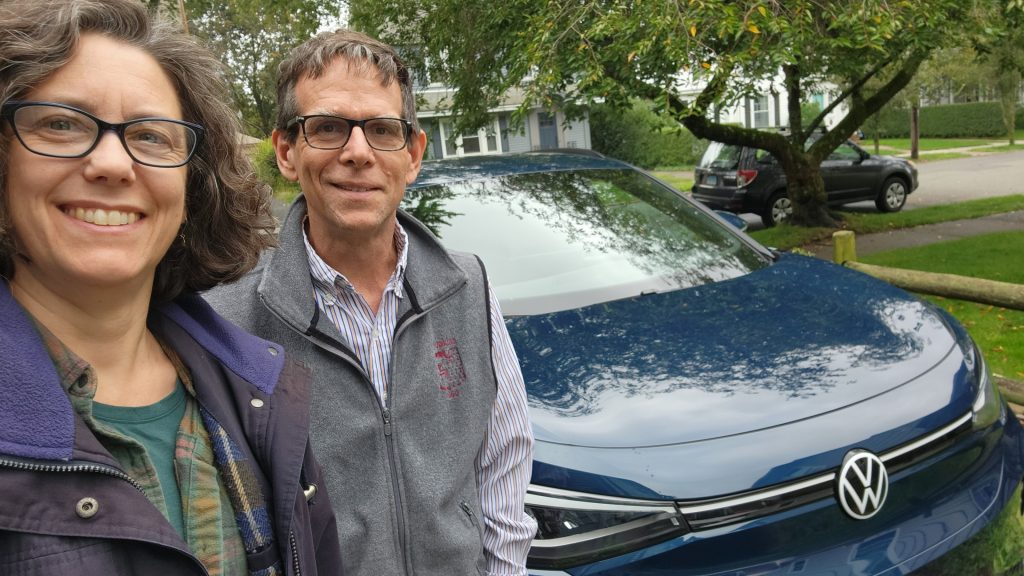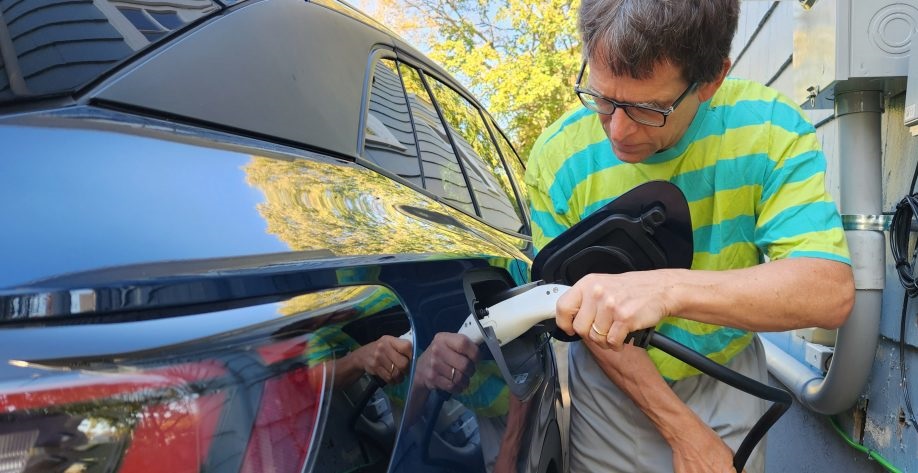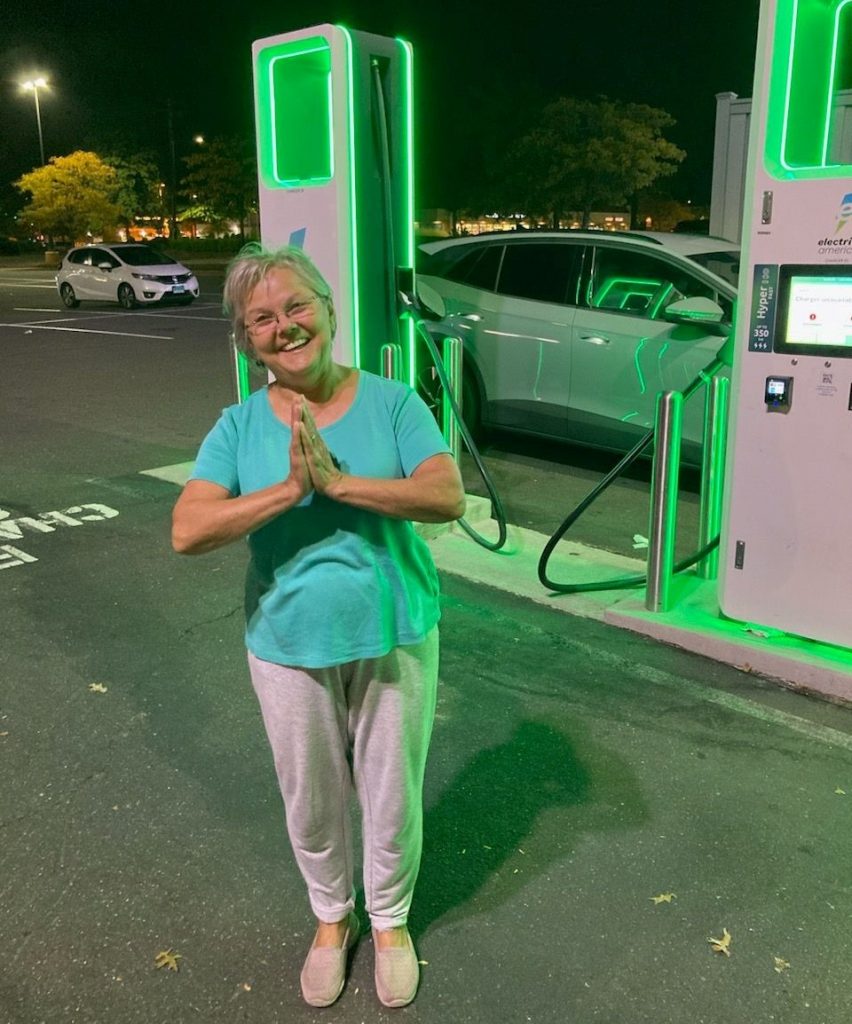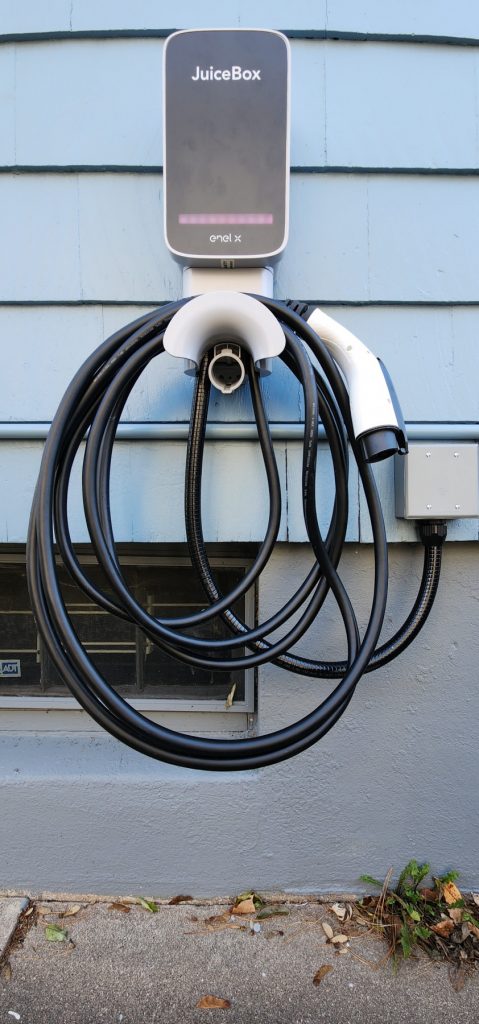Kathy Czepiel, Save the Sound’s land protection manager, gives an honest assessment of her experience with electric vehicle shopping, charging, and more. You can help bring EVs to more people in Connecticut by connecting with your legislators here.

I am never an early adopter. For years, my husband and I have been driving vehicles built in 2011 and 2012 and purchased by us when they were already used. We’ve quite happily avoided car payments for years. So, the fact that we are now EV drivers should tell you something: EVs are not a fringe fad. They’re just cars that ordinary people drive, and they’re here to stay.
That’s not to say that everything about getting used to our new EV has gone entirely smoothly. For starters, when we drove it off the dealership lot, we left the minivan we’d arrived in parked there and had to go back to retrieve it.
Beyond that oversight caused by our initial glee, there was a lot to learn. So, even if the idea of becoming an EV driver is currently just a twinkle in your eye, you may find our experience over the past few months informative and—hopefully—inspiring.
Shopping
Our EV was not an impulse purchase. In fact, we’d been seriously thinking about it for a year, ever since we’d made the leap to installing solar panels on our roof and realized we could plug in a car and run it on the power of the sun! How cool is that?
Over the course of that year, we did our research. We figured out which cars would qualify for the still-substantial state and federal rebates, and which cars wouldn’t but had manufacturers’ rebates that matched the government’s. In other words, we were looking for the “budget” end of the market, planning to stay under $40,000, which is not exactly a bargain—especially when we were accustomed to used car prices. We were disappointed to learn that the popular Chevy Bolt was being phased out and decided it wasn’t a good idea to buy the last of its kind (though Chevrolet is now reportedly talking about bringing it back, better, in the future).
We also had our eyes on two other vehicles, but neither one worked out. The Chevy Equinox wasn’t available yet but might be arriving this winter. Or not. We test drove a Hyundai Kona, but there was only one on the dealer’s lot, the salesman wasn’t very knowledgeable, and the car they gave us to drive had only 2% left on the battery and warned us to get back to the charger now! Maybe we shouldn’t have been so easily discouraged, but we didn’t love the car anyway, so we moved on.
A local VW dealership had 30 ID4s on their lot, so even though the ID4 hadn’t been on our initial list, we decided to take a look. That dealership was the only place where we saw anything like that kind of inventory, and we figured with 30 cars to sell, we might get a decent deal. We test drove the car twice, several weeks apart, as we thought it over and were rewarded for our patience with a late-in-the-month call offering to knock another $1,000 off the price tag. In the end, with the blessing of our financial advisor, we opted to lease instead of buying because EV technology is changing fast, and we didn’t want to get stuck with a car we couldn’t resell.
Bottom line: We’re really happy with our VW, but we sure wish CT dealers could have offered us better inventory and more options.
Charging
The part about owning an EV that makes people most nervous is charging—or, more precisely, not being able to charge when you need to. I took some very short trips, mostly to work, before I got up the courage for a longer drive.
The advertised range of the ID4 is 209 to 275 miles, depending on the version and driving conditions, but that’s if you charge it up to 100%–for normal use, 80% is recommended—and drive it down—although generally, 20% is recommended. I wanted a car with at least enough range to get me from my home near New Haven, CT to my parents’ place in New York State and home again, and with a full charge, the ID4 will do that, though it probably won’t be necessary, since there are numerous charging stations at their retirement complex.
It took a few weeks after purchasing the car to get our own home charger installed (more on that below), so in the meantime, we charged it at an Electrify America station. Our car came with three years of free charging on that network. Electrify America isn’t widespread yet, but as long as there’s one close to home, you can take full advantage.
Several apps are available to help you locate other chargers on any route. Generally, they’ll tell you whether these are regular or fast chargers (which took care of our car in 45 minutes). Apps will also tell you whether a station is available. They’re not foolproof, and sometimes you’ll find a broken charger. But, then, if you’ve ever taken a road trip, you know Google can lead you astray on whether a nearby gas station is really open, too.
On the first trip to the charging station, we needed a little help figuring out how it worked, but the community of EV drivers is still small enough that everyone seems excited to help. A woman named Danielle walked my husband through the process and told him someone else had done the same for her two weeks earlier.
Now that our home charger is installed, we can plug in when we get home from work, and sometimes the car is finished before we go to bed. An app lets us know how much time is left, and if we leave it overnight, it will stop automatically when it reaches the level we’ve set.
Bottom line: Charging is easy, and with a little bit of planning, you’ll be no less likely to run out of juice than you are to run out of gas.
Rebates and Programs
We never bought a hybrid car because even a few years ago, we couldn’t afford one. Despite today’s excellent rebates, the cost of EVs still puts them out of reach for many consumers. But as the market demands more and more EVs—and make no mistake, the transition is coming whether the government gets involved or not—prices will come down.
We were surprised how well our lease compared to a new car loan payment—less than $350 a month. Getting the $9,500 rebate ($7,500 federal and $2,000 state) on our lease was absolutely seamless. It was written right into the agreement. If you purchase your EV, you’ll have to apply for the rebate later as a tax credit.
Getting the $1,000 rebate for our home charger—$500 for purchase and an additional $500 toward the cost of upgrading our panel to 200 amps—was, unfortunately, a huge pain. These rebates are offered through your electric utility’s program, and UI’s process was terrible. Instructions on the website give contradictory information, navigation is not intuitive, and for no reason I could figure out, I was locked out of the online application, a problem no one seemed capable of fixing. Customer service was initially only by email, so it took days to receive a PDF of what turned out to be last year’s outdated application form. Finally, I found a phone number buried in the PDF’s instructions, and the second human I spoke to appears to have straightened things out, though I won’t be certain until the checks arrive.
UI also offers a managed charging program for additional cash incentives (or, possibly, gift cards). If enrolled, you agree to charge at off-peak times when electricity demand is high, such as during the hottest part of the day in summer—an approach that can help reduce pollution generated by power plants. Because of our friction-filled customer service experience with the rebates, I chose not to sign on. Simply knowing when the high demand times tend to be gives us enough information to be good stewards and avoid those times on our own without the hassle of dealing with a managed program. Hopefully UI will work out the kinks and future customers will have a smoother ride.
Bottom line: Generous state and federal rebates make it possible for some consumers who might not think they can afford it to drive an EV.

Regulations and improving the consumer experience
Supporting Connecticut’s proposed new Clean Cars standards is one way to help break down some of the current barriers to EV ownership in the state. The regulations, developed by California and already adopted by a growing number of other states including New York, Massachusetts, and Rhode Island, will bring more electric vehicles to Connecticut over the next decade and reduce air pollution from all vehicles.
The regulations require auto manufacturers to send an increasing percentage of electric vehicles to Connecticut. The requirement ramps up over time to keep pace with the buildout of the charging infrastructure and investments in our electrical grid that are already taking place.
Bottom line: That means a LOT more choice for people shopping for EVs—more models available, more cars on lots, and a greater range of price points.
These standards also include consumer protections like improved labeling and battery warranties, protections Connecticut will miss out on if we default to weaker federal standards.
Residents who want to stick with a gas car will still have options under this approach, too—the regulations don’t restrict purchase, ownership, or use of internal combustion engine vehicles. Even after 2035, folks who want to keep driving a gas-powered car can as long as they want, and can replace it with a new or used internal combustion vehicle (or an EV or hybrid!) when ready.
The Connecticut legislature’s Regulations Review Committee is voting on November 28, 2023 about whether to adopt the new standards. Save the Sound is urging state residents to support the standards and to tell legislators to do the same: use this form to send your legislators a message before Tuesday’s vote.



